Unit 5 Do you have a soccer ball?(第4课时)最新精华教案 (新版)人教新目标版七年级上
- 格式:doc
- 大小:34.00 KB
- 文档页数:2
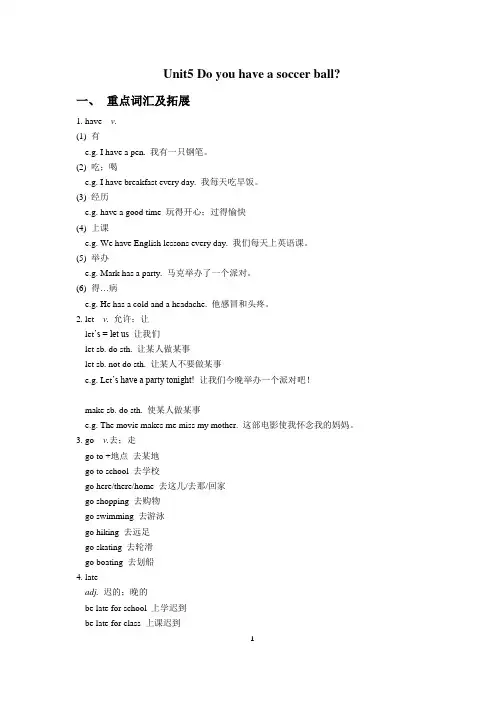
Unit5 Do you have a soccer ball?一、重点词汇及拓展1. have v.(1) 有e.g. I have a pen. 我有一只钢笔。
(2) 吃;喝e.g. I have breakfast every day. 我每天吃早饭。
(3) 经历e.g. have a good time 玩得开心;过得愉快(4) 上课e.g. We have English lessons every day. 我们每天上英语课。
(5) 举办e.g. Mark has a party. 马克举办了一个派对。
(6) 得…病e.g. He has a cold and a headache. 他感冒和头疼。
2. let v.允许;让let’s = let us 让我们let sb. do sth. 让某人做某事let sb. not do sth. 让某人不要做某事e.g. Let’s have a party tonight! 让我们今晚举办一个派对吧!make sb. do sth. 使某人做某事e.g. The movie makes me miss my mother. 这部电影使我怀念我的妈妈。
3. go v.去;走go to +地点去某地go to school 去学校go here/there/home 去这儿/去那/回家go shopping 去购物go swimming 去游泳go hiking 去远足go skating 去轮滑go boating 去划船4. lateadj. 迟的;晚的be late for school 上学迟到be late for class 上课迟到1be late for work 上班迟到adv. 迟地;晚地later adv. 后来;以后e.g. Three days later, he found his father. (句中有段时间+later,句子用一般过去时)三天后,他找到了他的爸爸。

——————————新学期新成绩新目标新方向——————————unit 5does 用于构成否定句和疑问句;做;干have 有tennis 网球ball 球pingpong 乒乓球 table tennis 乒乓球bat 球棒;球拍soccer (英式)足球soccer ball (英式)足球volleyball 排球basketball 篮球 basketball team 篮球队;basketball match 篮球比赛 basketball player 篮球运动员hey 嘿;喂let 允许;让us (we的宾格)我们let's 让我们(一起)let's us 让我们(一起)go 去;走we 我们late 迟到has (have的第三人称单数形式)有get 去取(或带来);得到great 美妙的;伟大的play 参加(比赛或运动);玩耍sound 听起来好像interesting 有趣的boring 没趣的;令人厌倦的fun 有趣的;使人快乐的n.乐趣;快乐difficult 困难的relaxing 轻松的;令人放松的watch 注视;观看TV 电视;电视机 many TVs 很多电视机watch TV 看电视same 相同的love 爱;喜爱with 和......在一起;带有;使用sport 体育运动 play/do/have sports 做运动 sports shoes 运动鞋a sports shoes 体育运动鞋them (they的宾格)他(她、它)们only 只;仅like 喜欢;喜爱easy 容易的;不费力的after 在......以后class 班级;课(近义词:lessen);等级;类别;阶段classmate 同班同学 roommate 室友 workmate 同事 deskmate 同桌schoolmate 校友Bill 比尔(男名)on的用法,详见unit4【解析】on可以表示“通过;使用……方式”,后面通常接表示通信工具的名词。

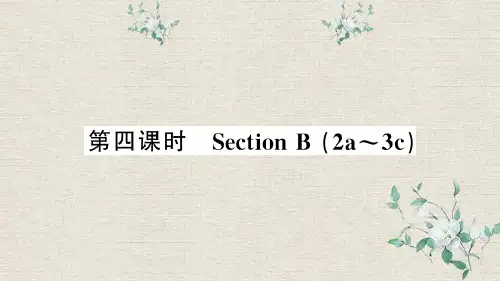
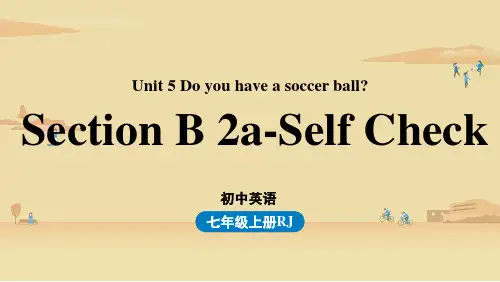
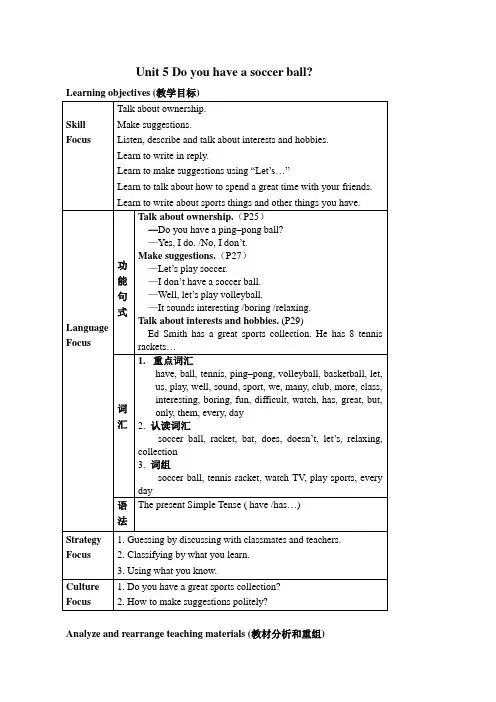
Unit 5 Do you have a soccer ball? Learning objectives (教学目标)Analyze and rearrange teaching materials (教材分析和重组)1. 教材分析本单元以“Do you have a soccer ball?”为话题, 共设计了三个部分的内容。
Section A该部分有4个模块:第一模块围绕“Do you have a soccer ball?”这一话题展开词汇学(1a)、听力(1b)、口语(1c)训练;第二模块继续围绕“Do /Does… have a…?”进行听力(2a-2b)、口语训练(2c);第三模块围绕“Make suggestions.”这一话题展开训练,训练形式为单词填空(3a)和角色表演谈论图画为训练形式(3b);第四模块就“Complete the forms according to the sports club you like.”以结对活动形式进行介绍。
Section B该部分有4个模块:第一模块是词汇的学习(1a)与运用(1b);第二模块仍然围绕(1a-1b) 的词汇进行听力训练(2a-2b)、围绕提建议进行口语训练(2c);第三模块继续围绕“Ownership”这一话题展开有关收藏品阅读(3a), 写作训练(3b-3c);第四模块仍就“Ownership”这一话题以口语训练形式展开全班活动。
Self Check该部分有3个模块:第一模块以填空形式对所学词汇进行训练;第二模块以默写已学过的五个单词的形式对所学的词汇继续巩固复习; 第三模块围绕有关ownership和suggestions对话开展口语训练和写作训练。
教材重组和课时分配Period 1 (Section A: 1a, 1b, 1c) New function presenting Period 2 (Section A: 2a, 2b, 2c, 3a, 3b, 4) PracticePeriod 3 (Section B: 1a, 1b, 2a, 2b, 2c) V ocabulary building Period 4 (Section B: 3a, 3b, 4) Integrating skillsPeriod 5 (Self Check: 1, 2, 3 & Workbook) Self CheckPeriod 6 WritingTeaching procedures and ways (教学过程与方式)Period One New function presentingLanguage goals (语言目标)1. Words & expressions: have, soccer ball, tennis, racket, tennis racket,ping–pong, volleyball, basketball, bat (P25)2.Key sentences: Do you have a ping–pong ball?Yes, I do. No, I don’t. (P25)Ability goals (能力目标)Enable the students to understand and talk about ownership and make suggestions.Emotion & attitude goals (情感和态度目标)Enable the students to form positive attitude toward sports collection and love sports, keep healthy and learn to make suggestions politely. Strategy goals (策略目标)To understand the target language by reading pictures, drawing pictures, countingnumbers, drawing a chart.Culture awareness goals (文化意识目标)People’s attitude toward sports collections is different in English speaking countries.Teaching important points (教学重点)Talk about ownership and make suggestions.Teaching procedures & ways (教学过程和方式)Step 1. Revision and Lead-inAsk one or more students to show their homework.T: In the last unit, I ask you to do a project about filling in the chart because we want to have a ball game. But we don’t know what kind of balls you have. Please ask your classmates in the group what balls he /she has. Then write down the information in the chart. Now who wants to display your project on the blackboard?T: Do you have tennis? S: Yes, I do.Second point to the others in the classroom.T: Does Wang Wei have tennis? S: Yes, he does.Third point to Li Hong in the classroom who has ping–pong ball, but no tennis.T: Do you have tennis?S: No, I don’t.T: Do you have a ping–pong ball?S: Yes, I do.T: Does Li Hong have tennis?Ss: No, she doesn’t.T: Does Li Hong have a ping–pong ball?Ss: Yes, she does.T: Today we are going to learn how to talk about ownership and make suggestions.Step 2. Listing and SpeakingAsk the students to read the picture on Page 25.T: What can you see in the picture?Ss: We can see a ping–pong ball, a ping–pong bat, a tennis racket, a soccer ball, volleyball, a basketball, a TV, a computer game.T: Ask the students to match the words with the things in the picture.Ss: Say, Number 1 is (C), tennis racket. Number 2 is (a), ping–pong ball…After checking the answers in 1a, ask the students to read aloud the new words again and again, ask and answer about them in pairs. And then play the recording again. This time students listen to conversation and circle the words they hear. And then check the answers. Students circle ping–pong bat and computer game.Step 3. Pair workAsk the students to read the example conversation. Have students repeat. And then point to the television in the illustration and substitute that word in the conversation. Have students repeat again. And then ask students to practice the conversation in pairs and remind them to use various objects from the illustration. As students practice, move around the classroom to check progress and help with pronunciation.Ask for more ideas from the students and write their ideas on the blackboard.p hone, cars, pencil case, eraser, pen, book, dictionary, watch, key, notebook, ring, sister , brother, chair, bookcase, CD, video tape, hat, desk, dresser…Show the following to the students and then ask them to practice in pairs.—Do you have a phone?—Yes, I do.—Do you have a CD?—No, I don’t.T: Now work in pairs, make conversations with the newwords in 1a and act it out around the students.Sample conversations:1. S1: Do you have a ping–pong bat?S2: Yes, I do.S1: Do you have a ping–pong bat?S2: No, I don’t.2. S3: Do you have volleyball?S4: Yes, I do.S3: Do you have a basketball?S4: No, I don’t.3. S5: Do you have a tennis racket?S6: Yes, I do.S5: Do you have a TV?S6: No, I don’t.Step 4. Homework1. Ask the students to do more practice as required in 1 c on Page 25.2. Ask the students to prepare the next period. Think about the usage of “Does she /he have…?”Period Two PracticeLanguage goals (语言目标)1. Words & expressions: does, doesn’t, let, us, let’s, play, well, sound,good, sport, we, many, club, more, class (P26)2. Key sentences:—Let’s play volleyball.—That sounds good. (P26)Ability goals (能力目标)Enable the students to make suggestions politely.Emotion & attitude goals (情感和态度目标)Train the Ss to make suggestions politely and take activity part in school sports club and keep healthy.Strategy goals (策略目标)Enable the students to match the problems and worries.Culture awareness goals (文化意识目标)Learn to how to make suggestions politely.Teaching important points (教学重点)Talk about making suggestions.Teaching procedures & ways (教学过程和方式)Step 1. RevisionBefore class, let’s have a revision. First make up a conversation with “Do you have…?”about ownership, and then in threes make up a conversation with “Do you have…? Does she /he have…?”Sample dialogues:1. S1: Do you have a soccer ball? S2: Yes, I do.S1: Do you have a basketball? S2: No, I don’t.2. S1: Do you have a computer game? S2: No, I don’t.S1: Do you have a ping–pong bat? S2: Yes, I do.S3: Does he have a computer game? S1: No, he doesn’t.S3: Does he have a ping–pong bat? S1: Yes, he does.Step 2. Listening PracticePlay the recording for the first time.T: Listen to the tape. You only listen.Play the recording for the second time. Then check the answers.T: You’ll hear the same conversation again in the picture. This time please listen for the names in the pictures, and then number the pictures (1-4).After that ask a few students to say out their answers in 2a.S1: The answers are 3, 1, 4, 2.S2: Number the pictures: 3, 1, 4, 2.Play the recording for the third time.T: You will hear the conversations for the third time. You are to match the people from activity 2a to the balls in the recording for the fourth time and then correct the answers.T: You listen to the tape and write the numbers from the pictures in 2b next to the correct balls.After doing listening, talk about the dialogue about 2b, and then ask some students to say out their answers in 2b.S3: The answers are 3, 2, 1, 4.S4: They are 3, 2, 1, 4.Step 3. Pair workLook at the things in the picture. Ask your partner if he /she has the things in 2c.Ask the students to act out the conversation in pairs.Sample conversations:1. S1: Do you have a dictionary? S2: Yes, I do.S1: Do you have an eraser? S2: No, I don’t.2. S3: Do you have a baseball? S4: No, I don’t.S3: Do you have a football? S4: Yes, I do.3. S5: Does Tom have volleyball? S6: Yes, he does.S6: Does Mike have a pen? S5: No, he doesn’t.Step 4. PracticeLook at 3a, point out the words in the box and then ask a student to read aloud the four words to the class.T: Fill in the blanks with the words from the box alone. I’m sure you’ll fill in the correct answers. And now who’ll tell me the answers? Please hand up if you know the answers. Oh, thank you, --------!S1: The answers are: 1. don’t,2. Let’s,3; have,4. soccer.T: You are right. Thank you. Now let’s practise reading aloud the conversations in pairs and act them out. And then tell the students how to make suggestions politely using “Let’s…!”For example:T: Let’s play ping–pong ball./ Let’s play tennis./ Let’s play volleyball…S: That sounds good.After finishing practising the conversations in 3a, ask the students to make conversations with their partners according to the pictures below in 3b. Ask the students to point to each one and describe each object. Show the students how to use the pairs of pictures as substitutes in the conversation.For example:T: Let’s play basketball.S: I don’t have a basketball.T: Well, let’s play football.S: That sounds good.Ask pairs of students to perform the conversation for the class and tell them how to make suggestions politely in 3b.Step 5. Writing and practiceThis activity gives students a chance to role play a conversation about sports. Students review the language of introductions, and then complete the form, introduce themselves to the coach.T: What sports do you like to play? Who are your favorite sportsmen and sports women? What sports are available at school?S1: I like to play football. My favorite sports man is Liu Xiang. Basketball and volleyball are available at our school.T: Our school has a sports Club with all the sport that you would like to play. If you would like to join the school sports club, please fill in the form with your personal information. When students have completed filling in the form, divide them into pairs.T: Wha t’s your first name? What’s your last name? What sports do you like? Do you like…? What class are you in?S: My first name is Li. My last name is . I like ping–pong ball. I’m in Class 4, Grade 7.Have students role play the conversation between a student and coach. Walk around the class and offer help where necessary.Step 6. SummaryAsk some students to sum up what we have learned key vocabulary and the target languages.Step 7. Today’s homeworkT: First make up dialogues with “ownership and make suggestions” in pairs /in groups. Next class I’ll ask you to act them out. Second, prepare for the next class P 28 (1a, 1b, 2a, 2b, 2c).Period Three New vocabularyLanguage goals (语言目标)1.Words & expressions:interesting, boring, fun, difficult,relaxing, watch, watch TV (P28)2. Key sentences: (1) Let’s play computer games.(2) That sounds interesting. (P28)Ability goals (能力目标)Enable the students to learn to make suggestions politely and responses.Emotion & attitude goals (情感和态度目标)Enable the students to learn to express their feelings about different suggestions.Strategy goals (策略目标)Enable the students to know how to express their feelings aboutdifferent suggestions.Culture awareness goals (文化意识目标)Different countries, different suggestions.Teaching important points (教学重点)Learn to how to express different suggestions and responses. Teaching procedures & ways (教学过程和方式)Step 1. Revision and word studyCheck the homework:T: Last class we asked the students to make up conversationswith “ownership and make suggestions”in pairs /ingroups. Now we’ll ask you to act them out.Point to the five words and ask the students to repeat each one,and then point to the five pictures and ask the students tomatch each picture with one of the words in section B (1a).Ask the students to write the letter of the picture on the linenext to each word.Ask the students to say out the answers. Go around the room,asking students to point to a picture and say the word that goeswith that picture. The answers are: 1. c; 2. d; 3. e; 4. b; 5. a.Step 2. Guessing the wordsThis activity makes students practise using the vocabularywords from this unit. Point to the picture in 1a and reviewthe words.T: Now please draw pictures that show somethinginteresting, boring, fun, difficult or relaxing. Please showyour pictures to some of your classmates. Everyone triesto guess the meaning.Step 3. Listening and word studyBefore playing the recording for the first time, point out thefive words in 1a above and ask a student to read them aloudto the class.Play the recording for the first time in 2a.T: Listen to the tape carefully and remember the fouradjective words you hear.Play the recording for the second time.T: Listen to the conversation and put a checkmark to the leftof each word in 1a that you hear.Ask the two students to say out their answers.Ss: The answers are: a. interesting; b. boring; c. fun;d. difficult;e. relaxing.Step 4. Listening and writingT: I’ll ask a student to read the name of each activity to theclass. And then I’ll play the tape. Listen to the tapecarefully for the first time and remember what Tony saysabout these activities. I’ll play the recording again. Thistime listen to the conversation and write the word in theblank.After listening to the tape for the second time, ask somestudents to read the same example to the class.Ss: The answers are: 1. interesting; 2. difficult; 3. boring; 4. fun.Step 5. Practice and actingBefore asking the two students to read the dialogues, listthese activities on the blackboard: play computer games,play volleyball, watch TV, play basketball.T: I’ll ask the two students to act out the dialogues, talkingabout the activities in 2b.One acts as Jenny, the other acts as Tony, move around theclassroom offering languages support and checkingprogress when the students talk about the activities. Ask afew pairs of students to perform their conversations for theclass.Sample dialogues:1. S1: Let’s play volleyball.S2: That sounds fun.2. S3: Let’s watch TV.S4: That sounds boring.Step 6. Summary1. This class we have learned how to make suggestions andresponses politely. We also have learned how to use somedescription adjectives.2. Prepare for the next class.Step 7. Today’s homework1. Make up dialogues about “Make suggestions and responses”.2. Prepare for the next lesson.Period Four Integrating skillsLanguage goals (语言目标)1. Words & expressions:has, great, collection, but, play sports,only,them, a great sports collection, tennis racket, soccer ball, onTV, everyday (P29)2.Key sentences: (1) Ed Smith has a great collection.(2) But he doesn’t play sports—he only watches them on TV.Ability goals (能力目标)Train the ability of the students about reading and writing.Emotion & attitude goals (情感和态度目标)Enable students to form wide interests and hobbies.Strategy goals (策略目标)Enable students to collect what they like.Culture awareness goals (文化意识目标)Enable students to understand different people have different interests and hobbies.Teaching important & difficult points (教学重点和教学难点)1. The plural form of noun.2. The Present Simple TenseTeaching procedures & ways (教学过程与方式)Step 1. RevisionFirst check the homework, and then ask a few pairs to act out the conversation about: Making suggestions and responses.T: Who can make up a dialogue about making suggestions and responses in pairs?S1: Let’s play football.S2: That sounds fun, but I don’t have a football.S1: Well, do you have a basketball?S2: Yes, I do.S1: Then let’s play basketball.S2: Oh, basketball is so different.S1: OK. Let’s play ping–pong ball.S2: That sounds boring. Let’s play computer game! Do you havea computer?S1: Yes, I do.S2: That sounds interesting.Step 2. ReadingBefore reading this magazine article, ask students to name everything they see in the picture (3a).T: Read the article by yourself, and then circle the vocabulary words that are about sports activities.Give examples such as a stamps collection or a coin collection.T: Please close your books, look at the overhead projector, listen to me carefully, and then fill in the blanks with the sports things in 3a. Please tell the students the answers.S1: 1. tennis racket; 2. basketball; 3. baseball; 4. soccer ball; 5. volleyballT: Y ou’re right. OK. Thank you! Pay attention to the usage of thePresent Simple Tense and the plural form of noun.Explain the usage of the grammar and some key sentences, ask the students to retell the text next class.Step 3. Reading and writingBefore reading this article, ask students to name everything they see in the picture (3b). And then read the article to the class. Ask students to look at the picture and fill in the blanks by themselves. After that, let the students correct the answers in pairs. Ask three students to write their answers on the blackboard. (The answers are: 1. baseball; 2. basketball; 3. tennis rackets; 4. volleyball.)After finishing filling in the blanks, explain the usage of the Present Simple Tense, the plural form of noun and some key words, key sentences. Ask students to recite the text (3b).Step 4. Writing and SpeakingT: After finishing learning the articles about 3a and 3b, now you write about yourself. Talk about your hobbies and interests such as:What sports do you play?What sports things do you have?What other things do you do? And so on.After a while I’ll ask some students to read their stories to the class.S1: I collect coins. I have ten American coins, five Russian coins.S2: I have a great toy cars collection. I have two Chinese toy cars, threeJapanese toy cars, four British toy cars. I play them every day.Step 5. Spoken English and writingNow look at 4 Survey, write “have,you, an alarm clock, do”on the blackboard.T: Please say the words in the correct order to make a question. Come tothe blackboard, Wang Fei.S1: Do you have an alarm clock?T: OK, you’re right. Thank you. Please write a student’s name under thequestion on the blackboard. Who can do it? OK, Yang Fan, please.S2: Li Gang.T: OK, Li Gang, please come to the blackboard. Do you have an alarm clock?Guide him to answer “Yes, I do. /No, I don’t.”S3: Yes, I do.T: Now, please write four questions like this. After that ask students to say other things they might ask. As the students complete the questions, move around the classroom checking progress and offering suggestions as needed, at the same time ask students to move around the room, asking their questions and writing in names. In this way the students learn the target language easily. Step 6. Today’s homework1. Write a story about your /his /her collection.2. Make up dialogue with “Do you have…?”3. Finish off all the exercises on the small blackboard.Period FiveLanguage goals (语言目标)1. Words & expressions: basketball, tennis racket, baseball bat, ping–pong ball,soccer ball, volleyball, interesting, boring, run, difficult, relaxing, TV2. Key sentences: (1) Do you have a ball? Yes, I do.(2) —Let’s play soccer.—That sounds good./It’s boring.Ability goals (能力目标)Train students’ writing abilities.Emotion & attitude goals (情感和态度目标)Learn to talk about ownership and make suggestions.Strategy goals (策略目标)Enable students to form wide interests and hobbies.Culture awareness goals (文化意识目标)Enable students to understand the different countries have different suggestions and hobbies.Teaching important & difficult points (教学重点和教学难点)Learn to how to talk about ownership and make suggestions. Teaching procedures & ways (教学过程与方式)Step 1. RevisionBefore class ask a few students to read aloud the stories about themselves, and then have some pairs act out dialogues about ownership. Also give students three minutes to have a free talk.Step 2. Words checkingThis activity provides a comprehensive review of key vocabulary presented in this unit.T: Now let’s go over key vocabulary in this unit. I speak Chinese, you speak English. First answer my questions one by one, and then answer my questions together. OK let’s begin.有趣的,无聊的,休闲的……篮球,网球球拍……Ss: Interesting , boring, relaxing…T: OK, so much for this. Now take out your English exercises books, write five new words in it, and then share your lists with your groups.Step 3. Reading and writingThis activity focuses on students understanding of the target language in the unit.T: Please read aloud the following sentences in 3a, and then number the sentences to make a conversation that follows the situations in the pictures by yourself.After a while, check the students’ answers. The answers are: 5, 1, 4, 2, 3, 6, 7.After checking the answers, ask the students to act out the dialogue and recite it.T: Now look at the chart on the blackboard with the names of five activities and five words at the top: interesting, boring, fun, difficult, relaxing. And then make up a dialogue talking about ownership and makingAsk two students to act out the dialogue.S1: Let’s play baseball!S2: That sounds interesting, but I don’t have a baseball.S1: …S2: …Step 4. Group workT: The class ball games will be held soon. The students in the class are training recently. Please give suggestions to your group and ask them to train after class.As you make up conversations, please use the drills “Do you have a…? /Yes, I do. /No, I don’t / Let’s… /No, it’s boring.”Step 5. Homework1. Finish off all he exercises in the workbook.2. Talk about your friends’hobbies. (play basketball /soccer ball /ping–pong ball /watch TV /play computer games /play sports every day)Period Six Writing(ppt展示)Teaching Resources (教学资源库)1.语法:(1) 名词复数的构成及读音规律:特别提醒:名词复数的不规则变化是:①只变元音字母,如:man—men, woman —women, foot—feet, policeman—policemen ②单复数形式一样,如:a fish—some fish, a Japanese —some Japanese ③其它变化,如:child—children等。
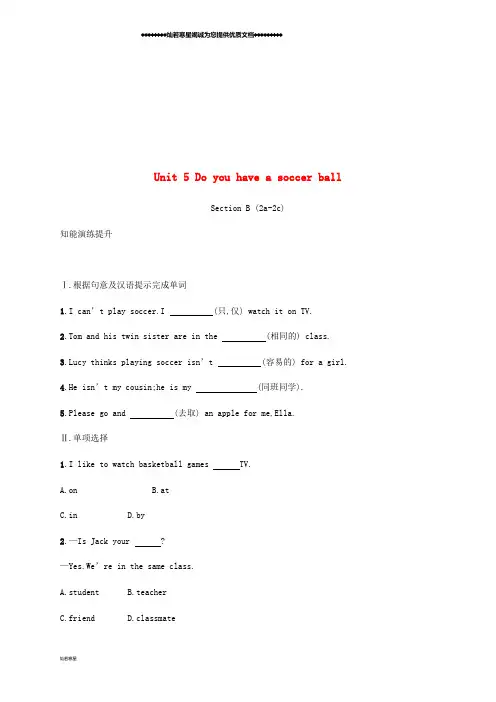
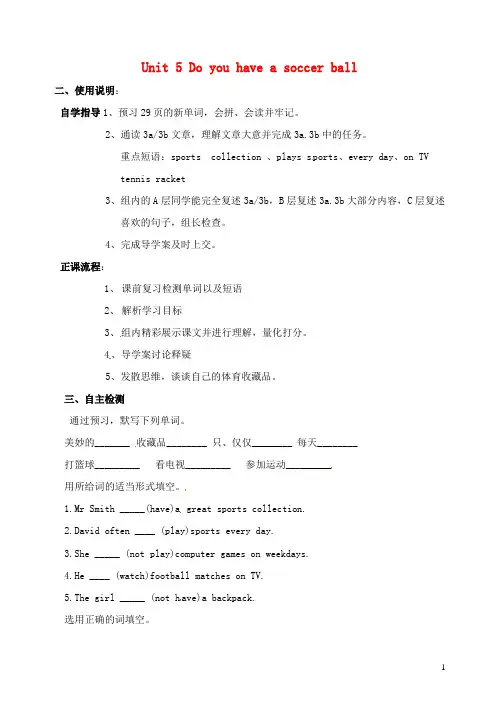
Unit 5 Do you have a soccer ball二、使用说明:自学指导1、预习29页的新单词,会拼、会读并牢记。
2、通读3a/3b文章,理解文章大意并完成3a.3b中的任务。
重点短语:sports collection 、plays s ports、every day、on TVtennis racket3、组内的A层同学能完全复述3a/3b,B层复述3a.3b大部分内容,C层复述喜欢的句子,组长检查。
4、完成导学案及时上交。
正课流程:1、课前复习检测单词以及短语2、解析学习目标3、组内精彩展示课文并进行理解,量化打分。
4、导学案讨论释疑5、发散思维,谈谈自己的体育收藏品。
三、自主检测通过预习,默写下列单词。
美妙的_______ 收藏品________ 只、仅仅________ 每天________打篮球_________ 看电视_________ 参加运动_________用所给词的适当形式填空。
1.Mr Smith _____(have)a great sports collection.2.David often ____ (play)sports every day.3.She _____ (not play)computer games on weekdays.4.He ____ (watch)football matches on TV.5.The girl _____ (not h ave)a backpack.选用正确的词填空。
1.What ________ Sue have? She has many sports things.2.Do you have some more paper? No, I ________.3.There ________ two football and a volleyball in the basket. 4.Let’s ________ good friends.5.________ you spell your name, please?6.________ there a football game on TV today?7.Sorry, I ________ answer the question. It’s too difficult. 8.Card ________ like sports. She thinks it’s boring.9.________ they need more s chool things?10.I ________ a football fan. I like it very much.根据汉语提示完成句子。
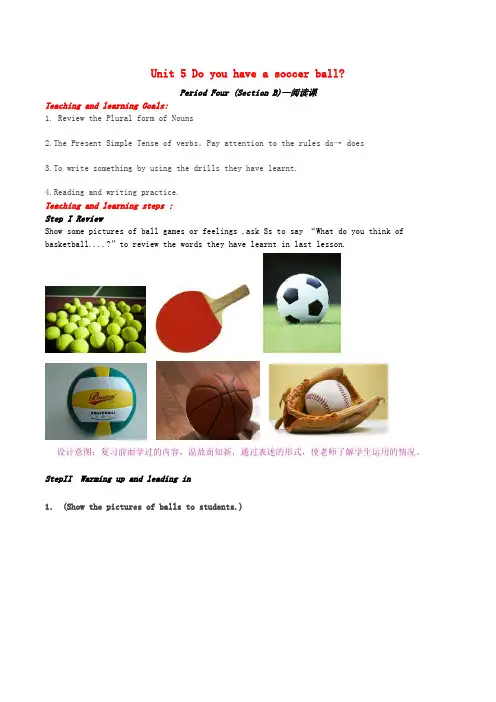
Unit 5 Do you have a soccer ball?Period Four (Section B)—阅读课Teaching and learning Goals:1. Review the Plural form of Nouns2.The Present Simple Tense of verbs。
Pay attention to the rules do→ does3.To write something by using the drills they have learnt.4.Reading and writing practice.Teaching and learning steps :Step I ReviewShow some pictures of ball games or feelings ,ask Ss to say “What do you think of basketball....?”to review the words they have learnt in last lesson.设计意图:复习前面学过的内容,温故而知新,通过表述的形式,使老师了解学生运用的情况。
StepII Warming up and leading in1.(Show the pictures of balls to students.)tennis racket s basketball sping-pong ball s and bat sT: I have two tennis rackets, three basketballs and four ping-pong balls and bats.This is my sports collection.(Repeat the collection several times and teach the new word.)T: What about you?(Ask some students to say something about their own collections.)S: I have three…2. T: I don’t have a soccer ball . Do you have a soccer ball ?Ss: Yes, I do./ No, I don’t.T: Let’s look at the three students. Frank Brown, Gina Smith, Wang Wei.Do they have a soccer ball?设计意图:利用学生的切身体会和实际情况引入新课,容易引起学生的关注,同时在复习过程中对名词的复数进行了复习。
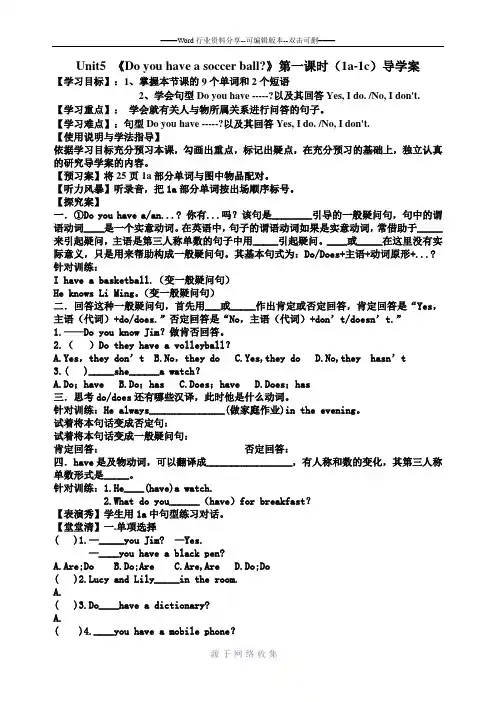
Unit5 《Do you have a soccer ball?》第一课时(1a-1c)导学案【学习目标】:1、掌握本节课的9个单词和2个短语2、学会句型Do you have -----?以及其回答Yes, I do. /No, I don't. 【学习重点】:学会就有关人与物所属关系进行问答的句子。
【学习难点】:句型Do you have -----?以及其回答Yes, I do. /No, I don't.【使用说明与学法指导】依据学习目标充分预习本课,勾画出重点,标记出疑点,在充分预习的基础上,独立认真的研究导学案的内容。
【预习案】将25页1a部分单词与图中物品配对。
【听力风暴】听录音,把1a部分单词按出场顺序标号。
【探究案】一.①Do you have a/an...? 你有...吗?该句是________引导的一般疑问句,句中的谓语动词____是一个实意动词。
在英语中,句子的谓语动词如果是实意动词,常借助于_____来引起疑问,主语是第三人称单数的句子中用_____引起疑问。
____或_____在这里没有实际意义,只是用来帮助构成一般疑问句。
其基本句式为:Do/Does+主语+动词原形+...? 针对训练:I have a basketball.(变一般疑问句)He knows Li Ming。
(变一般疑问句)二.回答这种一般疑问句,首先用___或_____作出肯定或否定回答,肯定回答是“Yes,主语(代词)+do/does.”否定回答是“No,主语(代词)+don’t/doesn’t.”1.——Do you know Jim?做肯否回答。
2.()Do they have a volleyball?A.Yes,they don’tB.No,they doC.Yes,they doD.No,they hasn’t3.( )_____she______a watch?A.Do;haveB.Do;hasC.Does;haveD.Does;has三.思考do/does还有哪些汉译,此时他是什么动词。
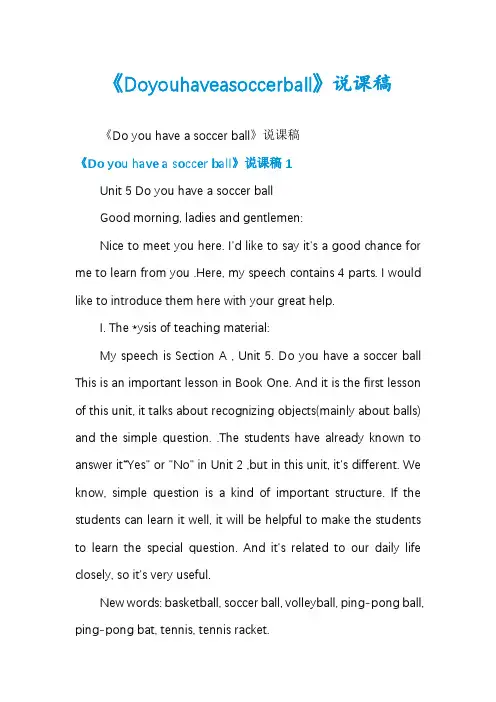
《Doyouhaveasoccerball》说课稿《Do you have a soccer ball》说课稿《Do you have a soccer ball》说课稿1Unit 5 Do you have a soccer ballGood morning, ladies and gentlemen:Nice to meet you here. I'd like to say it's a good chance for me to learn from you .Here, my speech contains 4 parts. I would like to introduce them here with your great help.I. The *ysis of teaching material:My speech is Section A , Unit 5. Do you have a soccer ball This is an important lesson in Book One. And it is the first lesson of this unit, it talks about recognizing objects(mainly about balls) and the simple question. .The students have already known to answer it“Yes" or "No" in Unit 2 ,but in this unit, it's different. We know, simple question is a kind of important structure. If the students can learn it well, it will be helpful to make the students to learn the special question. And it's related to our daily life closely, so it's very useful.New words: basketball, soccer ball, volleyball, ping-pong ball, ping-pong bat, tennis, tennis racket.Structure: Do you have Does he /she haveTeaching aims:Aims on the knowledge:To study the words about balls by showing the pictures.To make the students know how to ask whether others have something or not, and how to answer it.Aims on the abilities:To develop the students' ability of listening ,speaking, reading and writing.To train the students' ability of munication.Aims on the emotion:⑴.To make the students be interested in good co-operation and petition.⑵To make the students love sports ,love life.Teaching key points and difficult points:How to make the students understand the new language items naturally.How to make the students work well with their partners.How to arouse their interest in learning English.How to make dialogues and act them out.Ⅱ.Teaching methods I will take.1."Communicative" teaching method.2. "Task-based" teaching method.Everyone knows that the main aims of learning English in middle school is to cultivate the students' basic abilities of listening, speaking, reading and writing, and their good sense of the English language.Ⅲ. Learning methods.Firstly, Look, listen, and say to gain language petence.Secondly, Teamwork, exploration and participation to reach the goal.Thirdly, Cultivate skills in listening, speaking, reading and expressing.Fourthly, Students-centered and teacher-guided learning strategies. I'm not a teacher but a guider. I'm ready to give them help whenever they need and re-correct the mistakes while talking.Ⅳ.Teaching procedure design.Step1. Warm-up.Ask the students some easy questions to check if they have remembered the contents they had learned before. For example: What's this Spell it, please. What color is it Is this your pen Is thatyour backpack and so on.Step2. Presentation.1. Take out a ping-pong ball and ask the students:What's this Why I take out a ping-pong ball here I think it's the easiest and the most popular in our country.2. Leading in new words : here I will play some short plays, they are soccer game,volleyball game, ping-pong petition and an advertisiment, there is a basketball in it.The reason of my design: I think the students can learn the words easily and directly in this way. And I also think it can draw the students' attention and arouse their interest in learning English. With the help of the CAI, it can provide a real situation to understand the meaning of the words, not by presenting the new words one by one and telling them the Chinese meaning. So the students can remember the words quickly and naturally.How to help the students remember the new word, I think I will do it like this: When the word appears under the picture, there may be some students know the word and they will read it out loudly, this time, you may need to correct the pronunciation and teach it, after one or two times, I will ask the students to spell it by themselves. Why I must ask them to spell it themselves, I thinkit can make them have a general impression of the word. Usually, when you teach them read, most of the students just follow you, they don't look at the word at all. Perhaps, you have taught ten times and they can read it very well following you , but after you teach some more words and ask them to read it again ,they may not be able to.3.Teaching the dialogue:Make a sample dialogue with a student. Show him or her the ping-pong ball and do it like this:T: I have a ping-pong ball. Do you have a ping-pong ball (Here, you may help him answer "Yes, I do." or "No, I don't.") S: Yes, I do.Make the dialogue with some more students,and write it on the blackboard. Make sure they can read and understand the meaning. Next, ask a student if he has a ping-pong ball, then ask the others: "Does he have a ping-pong ball "Here, you must help them answer: "Yes, he does." Or "No, he doesn't." Write it on the blackboard. Teach the dialogue and make sure they can read it and understand the meaning.4. Practice: Read the dialogue by role play. But you must tell them how to do it clearly, make them to ask their partners whatkind of balls they have. This time ,they must use the sentence "Do you have a "5. Groupworking and petition: Divide the students into groups of three.Give them an example first :A: Do you have a basketballB: Yes ,I do.A: Does he have a basketballC : Yes, he does.Ask them to make a similar dialogue and tell them that it' s also a petition, after they act it out you will choose a best group at the end.The reason of having a petition: I think it can encourage them to try their best and cooperate with their groupmembers well.6. Listening, listen to the tape and circle the words you hear. It's Activity 1a.Step3. Post-task. Starting a ball club.In this club, there are four teams: a basketball team, a soccer ball team, a ping-pong ball team and a tennis team. I will ask four students to be the captain of each team. They should ask their classmates to be their team members. If he has a basketball,he should join the basketball team.The reason I give this task: I think this activity is the consolidation of this lesson. It is helpful to revise and consolidate the contents we learned in this lesson.Blackboard design:Ping-pong ball /bat Do you have a ping-pong ballSoccer ball Yes, I do./No, I don't.BasketballVolleyball Does he have a soccer ballTennis racket Yes, he does.Does she have a volleyballNo, she doesn't.That's my speaking. Thanks for your listening.《Do you have a soccer ball》说课稿2各位老师:大家好!今天我说课的内容是七年级英语上册第五单元第一课时,这一课时可分为三部分,一是要求掌握一些球类运动的名词,英语单词是学好英语的基础,只有掌握大量的英语单词,在丰富知识的同时,才能提高应用语言的能力;第二部分是听力训练;第三部分是口语训练Do you have a 。
Unit 5 Do you have a soccerball?主备课人:冉宏文第1课时Section A 1a—2c【学习目标】:1、掌握本节课的9个单词和2个短语2、学会句型Do you have -----?以及其回答Yes, I do. /No, I don't.【学习重点】:学会就有关人与物所属关系进行问答的句子。
【教学用具】:A tape recorder 、A tape【学习过程】:一、自主学习(教师寄语:Where there is a will, there is a way.)学习任务一: 熟练掌握本节课的9个词汇和2个短语。
过程:(1)个人试读,组内相互纠正发音。
(2)教师领读,学生纠正自己的发音(3)自己读并记住汉语意思,组内检查。
(4)小组竞赛,看谁记的快而多。
学习任务二:(1)认真观察1a的图画,将单词与图中物品搭配,小组讨论并核对答(2)听录音,完成1b,小组核对答案学习任务三: 熟练运用询问人与物所属关系的句型Do you have ----?及回答Yes, I do. /No, I don't.1、看图片1a,引入A:Do you have a pingpong ball?B:Yes, I do. /No, I don't.2、利用1a中物品来练习句型Do youhave----?Yes,I do.No, I don't.3、小组竞赛看谁练的快而多。
二、合作共建(教师寄语:Many hands make light work. )小组讨论:Do you have a soccer ball?中的you能否替换为he?三、系统总结(教师寄语:No man can do two things at once.)(1)这节课你学会了哪些表示球类的词。
(2)总结一下询问人与物所属关系的句型。
四、诊断评价(教师寄语:It's easier said than done.)(一)英汉互译:soccer ball_____________ tennisracket_____________有_____________球________排球____________篮球____________网球____________乒乓球_________球拍_________(二)选择:1、根据句意及首字母补全单词(1)Is that her e________(2)This is a pencil c_______(3)What's this ? It's a r______(4)E______me. Is this your pencil?2、选择(1)—Is this your eraser?—__________A.Yes, it's .B. Yes,it is.C.Yes,is.D.It is.(2)Is that ______ pencil sharpener?A.heB. himC. hisD.you(3)This is _____ bag.A. meB. IC. my.D.you(4) ----Is that his case? -----__________.A.Yes, that is .B.Yes, it isn't.C. No, it is.D.No, it isn't.3、完成下列句子(1)—______ _______(这是) your pencil?—______ , ________ ________(是,它是)(2)—_______ _______(那是)his book?—______, it _____(不,它不是).It is_______(我的)book.4、翻译下列句子(1)这是你的字典吗?不,它不是。
Unit 5 Do you have a soccer ball?【重点短语】1.have a volleyball 有一个排球2.play volleyball/tennis 打排球/网球3.have a ping-pong/table tennis 有一个乒乓球4.play ping-pong/table tennis 打乒乓球5.with our friends 和我们的朋友一起6.have a football/soccer ball 有一个足球7.play football/soccer 踢足球8.at school 在校,在上学9.play sports 做运动10.play computer games 玩电脑游戏11.watch TV 看电视12.in the same school 在同一所学校13.after class 下课后14.go to school 去上学【重点句型】1.—Do you have a ping-pong bat? 你有一个乒乓球拍吗?—No, I don’t. 不,我没有。
2.—Do they have a computer? 他们有一台电脑吗?—Yes, they do. /No, they don't. 是的,他们有。
/不,他们没有。
3 .—Does he have a tennis ball?他有一个网球吗?—Yes,he does. /No, he doesn’t.是的,他有。
/不,他没有。
4.He has two ping-pong bats.他有两个乒乓球拍。
5.They have a computer.他们有一台电脑。
6.I don't have a soccer ball, but my brother does.我没有足球,但是我兄弟有。
7.She doesn’t have a volleyball.她没有排球。
8.Let’s play basketball!让我们(一起)去打篮球吧!9.That sounds good.那听起来不错哦。
Unit 5 Do you have a soccer ball?1. Do you have......? Yes, I do. No, I don’t..你有……吗?是的,我有。
不,我没有。
Do they have......? Yes, they do. No, they don’t..Does he have......? Yes, he does. No, he doesn’t.Does she have......? Yes, she does. No, she doesn’t.在一般现在时中,句子的谓语动词若是实义动词,常借助助动词do或does来构成否定句或疑问句。
Does用于主语是第三人称单数的句子中,其他情况用do。
2. do/does1)作助动词,帮助构成一般现在时的否定句或疑问句,无意义。
Do you have a soccer ball? 你有足球吗?I don’t know. 我不知道。
Does Jim have a sister? 吉姆有妹妹吗?What does he like? 他喜欢什么?He doesn’t like English. 他不喜欢英语。
2) 作实义动词,“做,干”。
I do my homework every day. 我每天都做家庭作业。
Bob does his homework every day. 鲍勃每天都做家庭作业。
3) 在一般现在时中,do/does 可用来替代上文出现过的动词,以避免重复。
Do you have a soccer ball? 你有足球吗?Yes, I do. 是的,我有。
(do 代have)Does she have an eraser? Yes, she does.I don’t have a soccer ball, but my brother Alan d oes.我没有足球,但我的哥哥艾伦有。
3.Let’s do sth. “(让)我们做某事吧。
Unit5Doyouhaveasoccerball七年级上课文原文及重点编辑整理:尊敬的读者朋友们:这里是精品文档编辑中心,本文档内容是由我和我的同事精心编辑整理后发布的,发布之前我们对文中内容进行仔细校对,但是难免会有疏漏的地方,但是任然希望(Unit5Doyouhaveasoccerball 七年级上课文原文及重点)的内容能够给您的工作和学习带来便利。
同时也真诚的希望收到您的建议和反馈,这将是我们进步的源泉,前进的动力。
本文可编辑可修改,如果觉得对您有帮助请收藏以便随时查阅,最后祝您生活愉快业绩进步,以下为Unit5Doyouhaveasoccerball七年级上课文原文及重点的全部内容。
Unit 5 Do you have a soccer ball?Part 1 Words and Expressionsdo /duː/ (第三人称单数形式does /dʌz/) aux v.用于构成否定句和疑问句v。
做;干have /hæv/ v。
有tennis /’tenɪs/ n. 网球ball /bɔːl/ n.球ping-pong /’pɪŋpɔŋ/ n. 乒乓球bat /bæt/ n. 球棒;球拍soccer /'sɒkə(r)/ n。
(英式)足球soccer ball (英式)足球volleyball /’vɒlibɔːl/ n。
排球basketball /’bɑːskɪtbɔːl/ n.篮球hey /heɪ/ interj。
嘿;喂let /let/ v。
允许;让us /ʌs/ pron. (we的宾格)我们let’s = let us 让我们(一起)go /gəʊ/ v.去;走we /wiː/ pron.我们late /leɪt/ adj。
迟到has /hæz/ v.(have的第三人称单数形式)有get /get/ v.去取(或带来);得到great /greɪt/ adj。
Unit 5 Do you have a soccer ball第4课时分层训练[Section B2 2a2c]Ⅰ.汉译英1.看电视________________2.玩电脑游戏 ________________3.在同一所学校 ________________4.进行体育运动 ________________5.踢足球________________6.和我的同学们一起________________7.一个棒球棒________________8.下课后 ________________9.八个排球________________10.在电视上观看体育运动________________Ⅱ.根据句意及首字母提示补全单词1.—Do you have pingpong bats?—Yes, but I have o________ one.2.My books are on the bed. Can you get t________ for me?3.Tom is in Class One and Mike is in Class One, too. They are c________. 4.Cindy and her sister like the s________ color.5.A________ school, let's play volleyball.Ⅲ.用所给单词的适当形式填空1.________ he ________ (have) a baseball?2.Let ________ (we) play pingpong.3.She ________ (not play) sports every day.4.That ________ (sound) relaxing.5.We love ________ (we) teachers.6.Her brother ________ (have) a basketball.7.We have six soccer ________ (ball).8.My friend often(经常) ________ (play) tennis.9.He ________(like) playing pingpong with his classmates after class.10.My sister and I ________ (be) in the room.Ⅰ.单项填空( )1.—Paul and I are in the same class.—Oh, you are________.A.brothers B.teachersC.friends D.classmates( )2.John often plays ________ basketball with his classmates after ________ class.A.the; / B./; theC.the; the D./; /( )3.—Let's go and play pingpong!—________.A.That sound goodB.That sounds goodC.That sounds wellD.That sound well( )4.________Mary________soccer after school?A.Is; play B.Are; playsC.Do; plays D.Does; play( )5.English is ________ but ________.A.boring; difficultB.difficult; interestingC.good; niceD.many; more( )6.He likes watching sports games, ________ he ________ play them. A.and; doesn't B.but; don'tC.but; doesn't D.and; don't( )7.I don't like this game. It's________.A.fun B.boringC.interesting D.relaxing( )8.Sam________ sports every day.A.play B.playingC.plays D.to play( )9.—What________ do you like, Jenny?—Baseball.A.sport B.day C.color D.class( )10.—Does your father ________ sports every day?—Yes, he does.A.likes B.lovesC.plays D.playⅡ.按要求完成下列各题,每空一词1.I have five soccer balls.(改为否定句)I ________ ________ five soccer balls.2.He has a friend.(改为复数句)He ________ some ________.3.Jack plays basketball after school.(改为一般疑问句)________ Jack ________ basketball after school?4.Maria has a__nice__watch.(对画线部分提问)________ ________ Maria ________?5.I watch TV in the evening.(用she作主语改写句子)________ ________ TV in the evening.Ⅲ.完形填空Look at the boy. He is my brother. We are in the __1__ school. My brother likes sports very much and he __2__ a great sports collection(收藏). He has two __3__ and rackets, three basketballs, four baseballs and five soccer balls. He plays __4__ very well and he often watches sports games __5__ TV. He often says, “Let's __6__ …”I like sports, too. But I __7__ a great sports collection. I only __8__ three pingpong balls and two pingpong bats. After class, I always play pingpong __9__ my classmates. I think it is interesting and easy __10__ me.( )1.A.different B.sameC.easy D.difficult( )2.A.has B.haveC.to have D.having( )3.A.pingpong ball B.tennis ballC.tennis balls D.football( )4.A.a basketball B.the basketballC.basketballs D.basketball( )5.A.on B.inC.by D.under( )6.A.to play B.playC.playing D.plays( )7.A.doesn't have B.haveC.don't have D.has( )8.A.know B.thinkC.have D.like( )9.A.and B.withC.at D.in( )10.A.to B.ofC.with D.forⅣ.阅读理解Hello, I'm Gina. This is my room. It is very tidy. You can see a table in my room. There are two white cups on the table. White is my favorite(最喜欢的) color.I like these cups very much. You can see a green model plane on my desk. I like making(制作) model planes. A clock is on my desk, too. The clock is blue and it is my good friend. It wakes me up(叫醒我) every morning. What's that under the desk? Oh, it's a baseball. Baseball is my favorite sport. I often play it with my friend on weekends(在周末). I think it is fun.( )1.Gina likes________ best(最).A.blue B.greenC.white D.yellow( )2.Gina's model plane is________.A.on the table B.on the deskC.under the table D.under the desk( )3.Gina often plays baseball with her________.A.sister B.brotherC.cousin D.friend( )4.Gina thinks baseball is________.A.interesting B.easyC.difficult D.boring( )5.Which of the following is wrong(下面哪项是错误的)?A.Two cups are in Gina's room.B.The model plane isn't blue.C.Gina doesn't like the clock.D.Gina's room is tidy.Ⅴ.任务型阅读My name is Frank. I'm a student. My parents are English teachers. I have no brothers or sisters. I have an uncle. He is my father's brother. His name is John Smith. He has a great sports collection. He has four tennis balls, two pingpong bats and three baseball bats. Look! His tennis balls are under the chair. His pingpong bats are on the table. He plays pingpong every day. But I don't play pingpong. It's boring. I have three soccer balls. They are under the bed. And I play soccer every day.根据短文内容,回答下列问题。
Unit-5-Do-you-have-a-soccer-ball--教课教课准1.教课目1.学并掌握怎样用 have 物件的所属行提与回答;2.学并掌握用 let ’s⋯⋯提建,认识祈使句的观点;3.学并掌握球运以及其余要点;4.能就球运的行沟通;5.学并掌握怎样回“let ’s⋯⋯”的建;6.学并掌握当主第三人称数“have的” 化。
【Learningobjectives】1. Words & expressionshave(has); do(does); ball; volleyball; basketball; tennis; let us = let play sports; sound good; interesting; boring; fun; difficult; but; watch TV; every day.2. Key sentences-Do you have a soccer ball? -Yes, I do.–No, I don’t.-Does she have a tennis racket? -Yes, she does–. No, she doesn’t.-Let ’s play basket ballThat. sounds– good.He has 8 tennis rackets.But he doesn’ t play sports------he only watches them on TV!2.教课要点 /点【Important Points】1.听写: have; soccer ball; tennis racket; ping-pong;volleyball; basketball; bat点在于⋯相关球的音。
2.句型:Do you have⋯⋯?.Yes, I do. / No, I don’ t.Does she have⋯⋯? Yes, she does. / No, she doesn’ t.点在于助do 的运用。
矿产资源开发利用方案编写内容要求及审查大纲
矿产资源开发利用方案编写内容要求及《矿产资源开发利用方案》审查大纲一、概述
㈠矿区位置、隶属关系和企业性质。
如为改扩建矿山, 应说明矿山现状、
特点及存在的主要问题。
㈡编制依据
(1简述项目前期工作进展情况及与有关方面对项目的意向性协议情况。
(2 列出开发利用方案编制所依据的主要基础性资料的名称。
如经储量管理部门认定的矿区地质勘探报告、选矿试验报告、加工利用试验报告、工程地质初评资料、矿区水文资料和供水资料等。
对改、扩建矿山应有生产实际资料, 如矿山总平面现状图、矿床开拓系统图、采场现状图和主要采选设备清单等。
二、矿产品需求现状和预测
㈠该矿产在国内需求情况和市场供应情况
1、矿产品现状及加工利用趋向。
2、国内近、远期的需求量及主要销向预测。
㈡产品价格分析
1、国内矿产品价格现状。
2、矿产品价格稳定性及变化趋势。
三、矿产资源概况
㈠矿区总体概况
1、矿区总体规划情况。
2、矿区矿产资源概况。
3、该设计与矿区总体开发的关系。
㈡该设计项目的资源概况
1、矿床地质及构造特征。
2、矿床开采技术条件及水文地质条件。